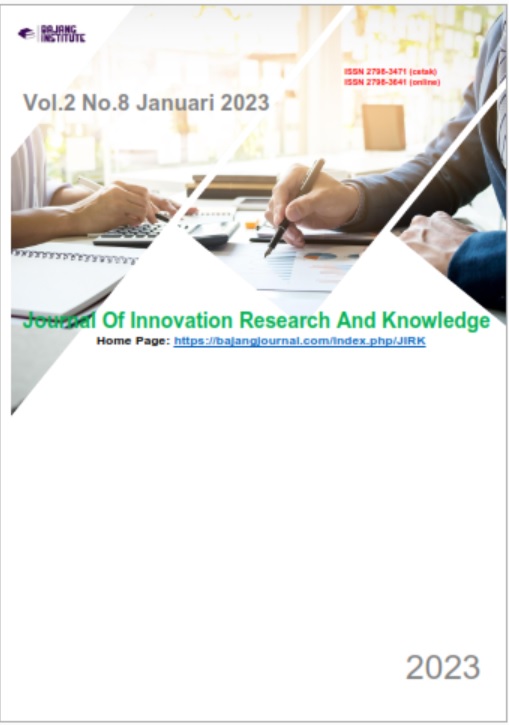EVALUASI GAYA HIDUP PASIEN DIABETES MELLITUS TIPE 2 TERHADAP PERILAKU BEROBAT DAN PENURUNAN PARAMETER GLIKEMIK: STUDI KOHOR BOGOR
DOI:
https://doi.org/10.53625/jirk.v2i8.5006Keywords:
GDP, GDPP, Diabetes Mellitus, Gaya Hidup, BerobatAbstract
Prevalensi Diabetes Mellitus (DM) tipe 2 di Kota Bogor sebesar 2,1% lebih tinggi dibandingkan prevalensi nasional 2,0% menurut laporan Riskesdas 2013. Penelitian ini bertujuan untuk menilai pengaruh gaya hidup terhadap penurunan parameter glikemik penderita DM tipe 2 pada studi kohort Penyakit Tidak Menular (PTM) di Kota Bogor dengan pemantauan selama 4 tahun. Pengumpulan data sekunder didapatkan dari dokumen kuesioner pada studi kohor PTM di Kota Bogor tahun 2011-2018. Hasil analisis sampel, total penderita DM tipe 2 pada pemantauan tahun ke-4 adalah 212. Hasil analisa terdapat 62 penderita DM tipe 2 yang berobat dan 150 penderita yang tidak berobat selama 4 tahun. Uji chi square kelompok berobat dan kelompok tidak berobat pemantauan tahun ke-4 menunjukkan perilaku penggunaan herbal (0.024) dan melakukan aktifitas fisik yag cukup (0.034) memiliki perbedaan yang bermakna (<0.05). Hasil analisis bivariat menunjukkan pada perubahan gaya hidup seperti merokok, aktifitas fisik, penggunaan herbal, olahraga dan pengaturan makanan tidak ada perbedaan bermakna (p-value >0.05) pada penurunan parameter glikemik GDP maupun GDPP selama 4 tahun. Diperlukan upaya promosi kesehatan yang berkelanjutan.
References
American Diabetes Association. (2017). Introduction: Standards of Medical Care in Diabetes. Diakses pada tanggal 16 Januari 2018, dari http://care.diabetesjournals.org/content/41/Supplement_1
American Diabetes Association. (2018). American Diabetes Association Releases 2018 Standards of Medical Care in Diabetes, with Notable New Recommendations for People with Cardiovascular Disease and Diabetes. [online] Available at: http://www.diabetes.org/newsroom/press-releases/2017/american-diabetesassociation-2018-release-standards-of-medical-care-indiabetes.html?referrer=https://www.google.co.id/ [Accessed 5 Jan. 2018].
DynaMed [Internet]. Ipswich (MA): EBSCO Information Services. 1995 - . Record No. 113993, (2017). Diabetes mellitus type 2 in adults; [updated 2017 Sep 22, cited place cited date here]; [about 96 screens]. Available from http://search.ebscohost.com/login.aspx?direct=true&db=dnh&AN=113993&site= dynamed-live&scope=site. Registration and login required.
Forouhar, E., & Sack, P. (2012). Non-traditional therapies for diabetes: fact or fiction. Journal of community hospital internal medicine perspectives, 2(2), 10.3402/jchimp. v2i2.18447. https://doi.org/10.3402/jchimp.v2i2.18447
Kaaffah, S., Soewondo, P., Riyadina, W., Renaldi, F. S., & Sauriasari, R. (2021). Adherence to Treatment and Glycemic Control in Patients with Type 2 Diabetes Mellitus: A 4-Year Follow-up PTM Bogor Cohort Study, Indonesia. Patient preference and adherence, 15, 2467–2477. https://doi.org/10.2147/PPA.S318790
Kementerian Kesehatan RI. (2013). Riset Kesehatan Dasar (RISKESDAS). Jakarta.
Kementerian Kesehatan RI. (2018). Riset Kesehatan Dasar (RISKESDAS). Jakarta.
McKennon, S. A. (2021). Non-Pharmaceutical Intervention Options for Type 2 Diabetes: Complementary Health Approaches and Integrative Health (Including Natural Products and Mind/Body Practices). In K. R. Feingold (Eds.) et. al., Endotext. MDText.com, Inc.
Soelistijo, S. A., Novida, H., Rudijanto, A., Soewondo, P., Suastika, K., Manaf, A. & Langi, Y. A. (2015). Konsensus pengelolaan dan pencegahan diabetes melitus tipe 2 di Indonesia 2015. PB. PERKENI.
Soewondo P, Soegondo S, Suastika K, Pranoto A, Soeatmadji D, Tjokroprawiro A. (2010). The DiabCare Asia 2008 study – outcomes on control and complications of type 2 diabetic patient in Indonesia. Med J Indonesia. (2010). 9(4);235-244.
Van Eikenhorst, L., Taxis, K., van Dijk, L., & de Gier, H. (2017). Pharmacist-Led Self-management Interventions to Improve Diabetes Outcomes. A Systematic Literature Review and Meta-Analysis. Frontiers In Pharmacology, 8. http://dx.doi.org/10.3389/fphar.2017.00891
World Health Organization. (2010).Global Recommendations on Physical Activity for Health.













